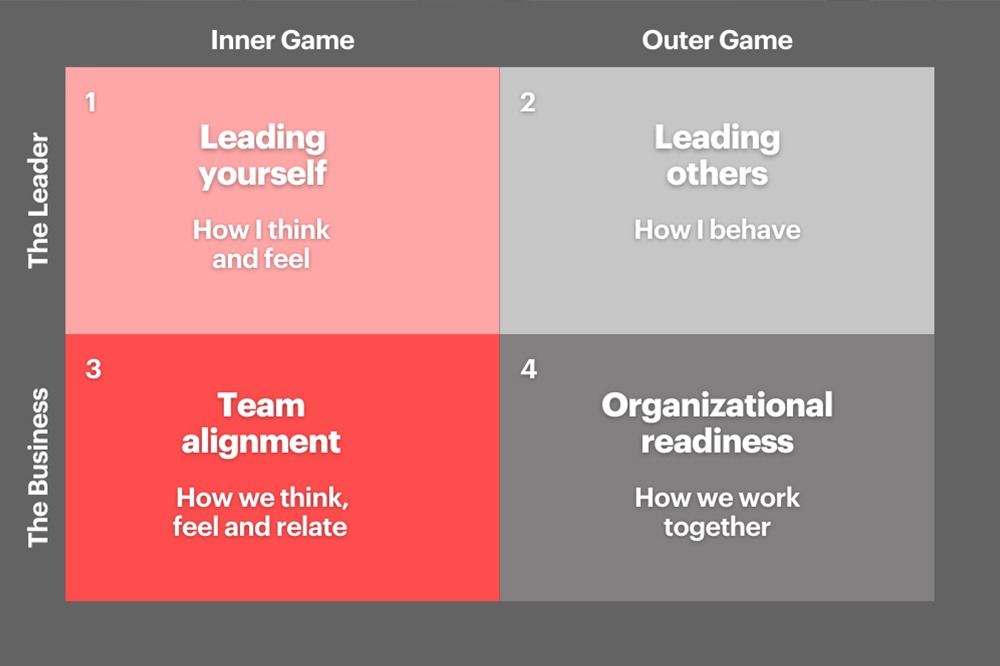If starting a company is hard, scaling it is even more demanding. Most ventures do not overcome the “entrepreneurial crisis” at the transition from startup to scale-up and ultimately stall or fail altogether. Data shows that only 7% of all firms in the European Union employ ten or more people. So, what does it take to scale a business from a few dozen employees to hundreds or even thousands?
For most entrepreneurs, scaling seems to be about developing the organization, i.e. building the team, implementing systems and processes, expanding into new markets, etc. And it is. But in today’s dynamic business environment, the success of a company is also intricately linked to the development of its leaders. As Sebastian Ross, Director of IESE’s School of Founders, explains: “Leaders often become an important barrier to growth for their firms.”
An integral framework for scaling
The School of Founders uses a framework that emphasizes these two sides of business building. The model is based on work from the philosopher Ken Wilber, who suggests analyzing any social phenomenon through four distinct lenses to generate a more holistic or “integral” view of the situation: First, he distinguishes between the perspectives of the individual (how I think, feel, and act) versus the collective (how we as a group or organization think, feel, and act). He then further differentiates what’s visible, tangible, and objective (the so called “outer game”) from the invisible, intangible, and subjective aspects of the situation (the “inner game”) that happen in people’s head.

Transferring this framework to the world of business and scaling, Ross then distinguishes four equally important dimensions of the scaling process that provide structure to the curriculum of the School of Founders:
- Organizational Readiness – The lower right quadrant contains the outer game of the organization and is titled “Organizational Readiness,” representing processes, systems, organizational models, and the technology needed to reach scale.
- Team Alignment – In the lower left, you have the inner game of the organization, called “Team Alignment” and referring to items like strategy, culture, and the psychology of teams that need to be articulated and managed in order to grow the business.
- Leading Others – The upper right quadrant, labeled “Leading Others,” refers to the outer game of the leader, including all the visible behaviors and skills required by the leader to scale the firm.
- Leading Yourself – Lastly, in the upper left is the often-ignored inner game of the leader, referring to the mental models that shape the leader’s thoughts, beliefs, values, and feelings.
Looking at the phenomenon of scaling through these four lenses is useful because it explicitly recognizes two often-forgotten realities of these journeys:
First, you need to scale yourself in order to scale your business. Leadership matters greatly. The vast majority of small firms never scale because their leaders don’t scale. They don’t acquire the requisite leadership skills (delegation, communication, feedback, etc.) and cannot cope with the exponentially increasing complexity of a growing firm. Their mental maps are too simple, too rough, not nuanced enough.
The other message this framework carries is that leaders need to focus on the inner game in order to win the outer game. This refers to self-leadership at the individual level (quadrant I) but also to building a psychologically healthy team and aligning it around strategy and culture (quadrant III).
“Most entrepreneurs join the School of Founders in search of tangible advice in areas like strategy, operations, finances etc. But they leave us grateful for having developed into a better leader. This encourages us to keep offering this balanced curriculum across these four areas,” says Ross.
Self-awareness and self-leadership: The inner game of the leader
At the individual level, leadership training traditionally focuses on the outer game (quadrant II), i.e. the acquisition of tangible competencies that leaders must master to guide their teams and organizations forward. That’s important, but not enough.
“Yes, we need to learn about theories, methods, and new skills. But becoming a leader is more than filling the mind with additional content. We also need to develop the mind itself,” explains Ross. “When someone is learning, she processes inputs through an existing mental model. When a person is developing, it is the mental model that changes. Someone egocentric, insecure, and uncompassionate can attend the very best training on feedback or coaching but will never be able to effectively deliver a tricky performance evaluation.”
Apart from skills and knowledge leaders need to refine the mental models through which they view the world. Only this enables them to make better, more informed decisions. Quadrant I points to qualities like self-awareness, self-leadership, emotional intelligence, and ultimately wisdom and higher consciousness—all indispensable competencies for managing large organizations in a fast-changing world. This might sound touchy-feely, but essentially, this inner journey is about becoming a better human. Or, as Ross eloquently states, “The process of developing extraordinary leadership is the same as becoming an extraordinary human being.”

Strategy and Culture: The inner game of the organization
Just as leaders have an inner game, so too do organizations. What people collectively think, believe, and feel, and how they relate to each other (quadrant III) is critical for how they behave and deliver results (quadrant IV). Leaders need to align the team around a small set of core concepts that guide decision-making and behavior.
This starts with strategy. When a company is small, strategic alignment happens almost automatically because you work out of the same room and speak all day. Yet, when the team grows to dozens of people over two or three hierarchical layers, delegation from the founding or leadership team becomes necessary. At that moment, when lower-ranked team members start making decisions autonomously, it becomes critical to have the strategy clearly articulated and communicated. Essentially, everyone in the company should be able to articulate, in their own words, what the company’s strategy is and make their decisions accordingly.
The same applies to the culture of a company—its values, shared beliefs, and behavioral norms. Articulating and implementing a healthy culture that fosters the right behaviors is essential for a fast-scaling company and requires significant attention from its leadership. You might not like the particular flavor, but successful scaling stories always have clearly defined and enforced cultural norms as a crucial success factor.
Consciously managing this inner game of the team becomes crucial for the scaling process. A dispersed organization with people pulling in all directions and behaving erratically cannot generate the forward momentum necessary for rapid growth. Drama and inefficiencies will wear people out and eventually cause the venture to stall.
IESE’s programs for managers are designed to help you develop the mindset and skills needed to navigate complex challenges and drive organizations forward.

















